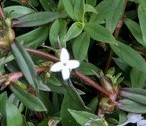 Virginia buttonwood is a perennial native to the United States. It is found in from Connecticut westward to central Kansas, and southward to the Gulf of Mexico and can be a troublesome colonizer of lawns. It tolerates close mowing and, in fact, may be encouraged by it. It likes fertile soil and plenty of moisture so is also found around ponds and other wet areas as well as in garden beds where a single plant can cover 2 square feet.
Virginia buttonwood is a perennial native to the United States. It is found in from Connecticut westward to central Kansas, and southward to the Gulf of Mexico and can be a troublesome colonizer of lawns. It tolerates close mowing and, in fact, may be encouraged by it. It likes fertile soil and plenty of moisture so is also found around ponds and other wet areas as well as in garden beds where a single plant can cover 2 square feet.
 Description: The stems of Virginia Buttonwood are 6-18” long and are usually trailing, forming roots at their nodes. They are angled and may have a reddish tinge. The dark green, opposite leaves are sessile (lack petioles), elliptical to lanceolate and 1-2’ long by 1” wide. They are somewhat thick and often mottled with yellow due to the presence of a virus that lives in close association with the plant. White, 4-petaled flowers ½” across are borne singly in the leaf axils from June to August and are followed by a small, green, ridged, hairy pod containing two seeds. The roots are deep and fleshy, and fragments can create new plants.
Description: The stems of Virginia Buttonwood are 6-18” long and are usually trailing, forming roots at their nodes. They are angled and may have a reddish tinge. The dark green, opposite leaves are sessile (lack petioles), elliptical to lanceolate and 1-2’ long by 1” wide. They are somewhat thick and often mottled with yellow due to the presence of a virus that lives in close association with the plant. White, 4-petaled flowers ½” across are borne singly in the leaf axils from June to August and are followed by a small, green, ridged, hairy pod containing two seeds. The roots are deep and fleshy, and fragments can create new plants.

 Control: Plants are best dug out when the soil is moist taking care to remove all of the roots or they will resprout. Inevitably some roots will remain and so new plants will appear but by repeatedly removing new plants control can be achieved. Alternatively, Virginia Buttonwood can be discouraged by reducing the amount of irrigation water since it prefers wet sites. Good lawn practices such as coring and appropriate mowing height help to encourage desirable grass species and reduce Virginia Buttonweed growth. Preemergent herbicides are not generally successful but several applications of a post-emergent herbicide can bring an infestation under control.
Control: Plants are best dug out when the soil is moist taking care to remove all of the roots or they will resprout. Inevitably some roots will remain and so new plants will appear but by repeatedly removing new plants control can be achieved. Alternatively, Virginia Buttonwood can be discouraged by reducing the amount of irrigation water since it prefers wet sites. Good lawn practices such as coring and appropriate mowing height help to encourage desirable grass species and reduce Virginia Buttonweed growth. Preemergent herbicides are not generally successful but several applications of a post-emergent herbicide can bring an infestation under control.